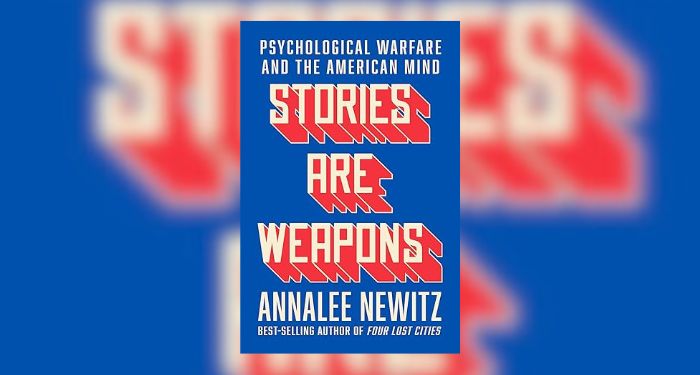
A Timely Look at Disinformation and Manipulation: Read an Excerpt of STORIES ARE WEAPONS by Annalee Newitz
Struggling to understand what’s happening in the world today? Consider yesterday with Annalee Newitz, author of Four Lost Cities: A Secret History of the Urban Age and Scatter and The Terraformers. Newitz is back with Stories Are Weapons: Psychological Warfare and the American Mind, an incisive and timely exploration of propaganda, manipulation, and disinformation.
Stories Are Weapons traces America’s deep roots in weaponizing stories through media and influence campaigns to take a critical look at the battles around identity, including school boards and LGBTQ+ students, race, and feminism, dividing Americans now.
In this excerpt from the first chapter, find out how Freud’s nephew used what he learned from his uncle manipulate the media and topple a government (to popularize bananas in the United States!), and what Cold War psyops have in common with advertising campaigns.
Stories Are Weapons: Psychological Warfare and the American Mind is available June 4 wherever books are sold.
The Mind Bomb
Modern psychological warfare began in the plush Vienna offices of an early twentieth-century doctor named Sigmund Freud, who popularized a new scientific discipline called psychoanalysis. In his writing and lectures, Freud argued that psychoanalysis had identified “the unconscious,” a veiled part of the mind that motivates people even when they aren’t aware of it. For Freud, unconscious desires were the key to understanding why people developed mental health problems, or “neuroses,” as he liked to call them. With the help of a doctor like himself, trained in psychoanalysis, that desire could be made conscious and therefore controllable. He had some success with patients suffering from what therapists today would likely call depression and trauma. But many enthusiastic Freudians used his work in contexts that the doctor never intended, like advertising and wartime propaganda. No doubt he would have psychoanalyzed the hell out of these misappropriations, but he never got the chance. Freud died in 1939, shortly after Nazis drove him and his family out of Vienna.
Freud wanted to cure neuroses by helping people understand themselves—especially the taboo desires hidden in their unconscious minds. His form of therapy involved asking patients about their dreams, early memories, and fantasies; it was his way of plumbing their unconscious minds, where desire can roam free. He called it the “talking cure.” Patients would narrate their own lives and analyze the arcane symbolism of their dreams, slowly piecing together all the events and feelings that had caused their troubles. Once the patient had a coherent story about themselves, Freud believed, they could work through whatever harmful thoughts or behaviors plagued them. If, however, they did not reengineer what Freud called the “mechanism” of their consciousness,1 they were liable to be aggressive, depressed, self-destructive, or delusional. It turned out this also made them easy targets for propaganda.
We know that because savvy advertising creatives in New York City conducted what amounted to mass psychological experiments in the 1920s, when they started using Freud’s ideas to sell products. The most prominent among them was Freud’s own nephew, Edward Bernays, often heralded as the creator of “public relations” as a field. Bernays grew up in New York City, though he spent summers with Freud’s family in the Alps—the two families were close, perhaps because all the parents were related. Bernays’s mother was Freud’s sister, and Bernays’s father was the brother of Freud’s wife. In 1917, Bernays sent his uncle a box of the Havana cigars he loved, and the psychoanalyst returned the favor by sending his nephew a copy of his latest book, Introductory Lectures on Psycho-Analysis. Though Freud’s previous books had made waves in the scientific community, this was his first mainstream hit. The short book popularized Freud’s conception of the unconscious and its connection to dreams. It also paved the way for Bernays’s own meditation on psychology in 1923 called Crystallizing Public Opinion, which was about how to persuade the public by using mass media like newspapers to appeal to their unconscious biases.
One of Bernays’s early career triumphs was an advertising campaign for Lucky Strike cigarettes in 1929, aimed specifically at young women. Smoking had long been considered a male habit, and it was generally taboo for women to smoke publicly. Bernays wanted to change all that and open up a new market for cigarettes. Freud had taught Bernays that the dream logic of the unconscious mind included a kind of emotional free association, where desire for one thing could easily morph into desire for something completely different—at least, if the two desires could be made to intertwine somehow. His only question was, what did women want, and how could Bernays convert it into a hankering for cigarettes? Young women in America at that time were still electrified by the success of the suffrage movement and were excited to pursue the newfound freedoms that came with the voting rights they had secured in 1920. So Bernays decided to create a campaign that could sublimate women’s love of freedom into a lust for cigarettes. All he needed was the perfect mass media vehicle—one that fed women’s dreams. He worked his connections and got in touch with Vogue magazine. Somehow he convinced the fashion magazine to give him a list of New York’s hottest debutantes so that he could invite them to a “Torches of Freedom” demonstration. He pitched it as an event where the city’s wealthiest young women would light up cigarettes at the annual Easter Day Parade, flaunting their liberation.
It was the perfect spectacle for the photo-hungry media, and the campaign was a roaring success. Women whose emotions were roused by thoughts of “freedom”—and by the sight of so many female influencers—started buying cigarettes and smoking them openly. As psychologist Lisa Held puts it, “Bernays was duly convinced that linking products to emotions could cause people to behave irrationally. In reality, of course, women were no freer for having taken up smoking, but linking smoking to women’s rights fostered a feeling of independence.”2 In the wake of Bernays’s success with the Lucky Strike campaign, advertisers began to study psychology to figure out ways to manipulate the unconscious minds of consumers. They would lure consumers in with emotional appeals or by associating a product with some political ideal like freedom.
Bernays’s work was strongly influenced by progressive journalist Walter Lippmann, founder of the New Republic magazine, who had worked in the US propaganda office during World War I.3 After his wartime experiences, Lippmann published a polemic called Public Opinion, in which he argued that democracy was being eroded by media manipulation and propaganda. Bernays’s book Crystallizing Public Opinion was a sardonic tip of the hat to Lippmann’s, whose ideas he cited while drawing the opposite conclusions. Bernays was thrilled by the power of media, and explained in step-by-step detail how intrepid public relations managers could use it effectively for advertising, corporate messaging, and political persuasion. Bernays described PR work as the “engineering of consent,” and called it a new form of free speech. He wrote, “Freedom of speech . . . and [the] free press have tacitly expanded our Bill of Rights to include the right of persuasion.”4
The truly creepy part? Bernays had successfully turned his uncle’s project to promote mental health into a system for manipulating people into behaving irrationally. Instead of helping people understand what they truly desired in their unconscious minds, he invited them to displace those desires onto something else, something they could buy. His Lucky Strike campaign channeled women’s hopes for freedom into nicotine addiction. But Bernays always wanted to go beyond selling cigarettes. He believed that public relations campaigns could be done for countries just as easily as for corporations. Roughly twenty years after he got feminists hooked on smoking, Bernays used his media-manipulation skills to topple a nation’s government.
Freud, again, provided an inspiration for Bernays’s foray into international politics. In 1921, the psychoanalyst published a monograph called Group Psychology and the Analysis of the Ego, in which he suggested that humans had a “herd instinct” and could easily be led into irrational behavior by influencers. Though Freud imagined those influencers to be patriarchs—fathers, heads of state, religious leaders—Bernays realized that they could be anyone, from a debutante to a grubby newspaperman. Freud thought that the herd mentality was dangerous and could lead to political catastrophe. Lippmann, who feared its power over the free press, agreed. But Bernays embraced it.
At the dawn of the Cold War, Bernays was hired to run a campaign for United Fruit to popularize bananas in the United States. Most were from Guatemala, where the government allowed United Fruit (now Chiquita) to own 42 percent of the country’s land, where it grew crops on vast plantations without paying local taxes. Bernays’s plans to make bananas the number one American snack hit a snag when Guatemalans elected Jacobo Árbenz Guzmán (known popularly as Árbenz), a reformer who wanted to stop colonial-style exploitation, in 1951. Árbenz began to confiscate uncultivated plantation lands, including 210,000 acres belonging to United Fruit. He divided the plantations up into one hundred thousand plots and handed them over to impoverished Guatemalans. Árbenz also demanded higher wages for agricultural laborers. Bernays was outraged. His campaign to gin up demand for bananas was reaching a fever pitch, but his client was losing both land and money. While the United Fruit PR team continued to regale Americans with stories about the wonders of bananas, Bernays worked with the CIA to get his clients’ plantations back.
Using his business connections, Bernays activated a network of spies in Guatemala to get intel on Árbenz’s background and any connections he might have to the Soviet Union. According to Larry Tye, author of The Father of Spin: Edward L. Bernays and the Birth of Public Relations, Bernays claimed that a trustworthy source had told him that Guatemalan “Reds” were using weapons supplied by the Soviet embassy in Mexico City. He leaked intel like this to carefully selected journalists and soon the papers were full of rumors about Guatemalan communists plotting to take over the country. Colleagues in the United Fruit PR department found Bernays’s tactics distasteful. Tye writes, “Thomas McCann, who in the 1950s was a young public relations official with United Fruit, wrote in his memoir that ‘what the press would hear and see was carefully staged and regulated by the host. The plan represented a serious attempt to compromise objectivity.’ ” Still, Bernays’s plot worked: thanks in large part to what he called a “scientific approach” to “counter-Communist propaganda,” many people in the United States came to believe that Guatemala was a threat. Few journalists questioned why a small group of anti-Árbenz forces was able to stage a coup in 1954, overthrow Guatemala’s democratically elected government, and hand thousands of small Guatemalan-owned farms back to United Fruit. In 1997, declassified documents revealed that the CIA had aided the men behind the coup with training and supplies—and their black ops were justified by stories about a communist threat, spread by a PR guy who wanted to sell bananas.5
To understand how psychological warfare developed in the United States, we need to keep in mind the bloody tale of Bernays and his banana propaganda.
The Bible of Psywar
When Paul Linebarger was writing Psychological Warfare for the US Army in the late 1940s, he was operating in the world that Bernays and Madison Avenue had made. Equally important, he benefited from a push within the Army to establish what became known as the Office of Psychological Warfare, headed by Brigadier General Robert McClure.6 Before 1951, the military had had no ongoing units devoted exclusively to psyops—generally psywar units were brought together temporarily during periods of war, drawing personnel from different groups devoted to irregular warfare or information management. But as the Korean War heated up, Army leadership determined that these disparate efforts should be unified under McClure—and that psywar units would no longer be disbanded during peacetime.
Unlike McClure, Linebarger does not usually appear front and center in histories of Cold War psyops, and he preferred it that way. He was an academic and operative who worked behind the scenes, as much an observer of psywar as a practitioner of it. Perhaps that’s why he was in the perfect position to write Psychological Warfare. It was one of the first military handbooks to codify a number of ad hoc practices for controlling large masses of people in order to win a war, using public relations and mass media. The book, originally a classified pamphlet made available to select Army personnel in 1948, became the first teaching manual for people working within McClure’s newly organized psywar units. The influence of Linebarger’s book during the Cold War spread outward from the Army and into the intelligence community at large. Journalist Scott Anderson, author of The Quiet Americans: Four CIA Spies at the Dawn of the Cold War,7 describes how much the book meant to a young CIA agent named Rufus Phillips III. Phillips had joined a dozen other operatives for a new initiative described by their commander, Edward Lansdale, as “whatever we can do to save South Vietnam.” It was 1954, and they had no idea what to do. But then Lansdale handed Phillips a copy of Linebarger’s Psychological Warfare, which Phillips called the “bible on the topic.” Reading that book was his only training. Within weeks, Phillips was designing crash courses in psyops for the South Vietnamese military.
Thanks in part to Linebarger’s work, Cold War psyops came to resemble an advertising campaign backed up by violence. It was an approach he had first seen implemented during World War II. “The war we have just won was a peculiar kind of advertising campaign, designed to make the Germans and Japanese like us and our way of doing things,” he wrote in Psychological Warfare. “They did not like us much, but we gave them alternatives far worse than liking us, so that they became peaceful.”8 Those “alternatives” included what his contemporaries called simply the Bomb.
The Bomb was the kinetic weapon that shaped the Cold War mindset. Everyone from American schoolkids to Soviet nuclear scientists had witnessed atomic bombs obliterating Hiroshima and Nagasaki, and now humanity was living with the reality of a weapon that had never existed before: one that could actually wipe out our species. The world’s greatest nuclear powers, the United States and the Soviet Union, needed sneaky ways to attack each other without directly declaring a war that could cost them everything. Psyops were one way to do it. During this period, both nations established military and intelligence bureaucracies that waged an icy battle of ideologies. Their episodes of brinkmanship exploded into violence during the Korean War, the Vietnam War, and many other proxy battles throughout the world. But the superpowers’ attacks on each other were counterbalanced by a profound fear of nuclear war. Cold War psychological warriors used that fear the way atomic weapons manufacturers used uranium.
Linebarger’s work depended on the idea that psyops campaigns would always be overshadowed by the threat of nuclear annihilation. Directly after the bombing of Hiroshima and Nagasaki, as the horrors of those attacks were still unfolding, he worked with the US Army to create one of the most important influence campaigns of the war: the United States leaked the Japanese government’s offer of surrender while the terms were still being negotiated. Linebarger described how the operation went down:
The Japanese government pondered [the conditions of surrender], but while it pondered, B-29s carried leaflets to all parts of Japan, giving the text of the Japanese official offer to surrender. This act alone would have made it almost impossibly difficult for the Japanese government to whip its people back into frenzy for suicidal prolongation of war.9
Linebarger believed this campaign worked partly because “so many people [were] being given so decisive a message, all at the same time.” The mass dissemination of the message was as important as the message itself. To sway public opinion, US psywarriors needed the Japanese masses to understand that a surrender was in the works before the government could walk it back. As Linebarger wrote, the United States won largely because they “got in the last word.”
Linebarger added his own peculiar expertise to the mix of psychology and public relations that defined twentieth-century propaganda. In his secret life as Cordwainer Smith, he was publishing some of the most acclaimed science fiction stories of the 1950s and ’60s. He was brilliant at building imaginary worlds that felt so real that some of his readers were convinced the secretive author was a covert agent from a distant future. Literary critic Gary Wolfe, who has written extensively about Linebarger’s fiction, told me that “so much is unexplained [in Smith’s stories] that readers assumed the writer had forgotten to fill in background because he knew it to be true. People thought he was an actual time traveler.”10 It turned out to be the perfect skill for a propagandist.
Excerpted from Stories Are Weapons: Psychological Warfare and the American Mind. Copyright (c) 2024 by Annalee Newitz. Used with permission of the publisher, W. W. Norton & Company, Inc. All rights reserved.
The comments section is moderated according to our community guidelines. Please check them out so we can maintain a safe and supportive community of readers!













Leave a comment
Become an All Access subscriber to add comments.